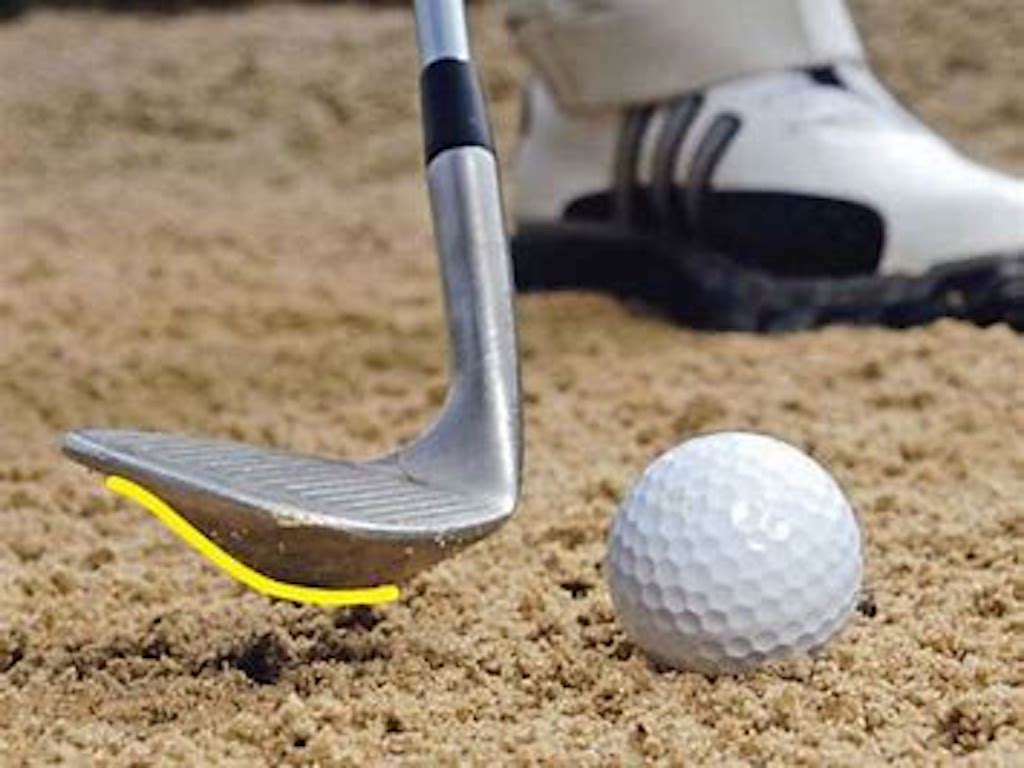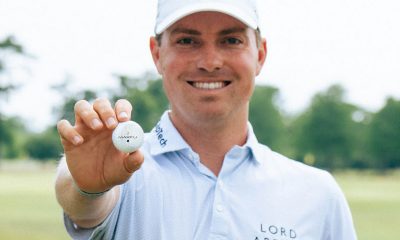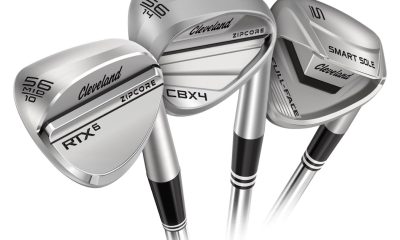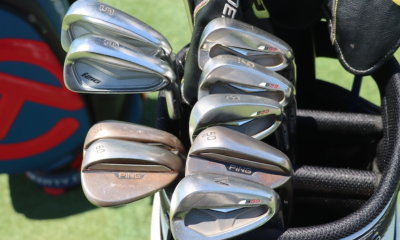Opinion & Analysis
The Wedge Guy: “Sole” food, Part 2

Writing for a knowledgeable and diverse crowd like you GolfWRXers is not easy, but I thank you for keeping me on my toes. Last week’s article was titled “A Discussion of Bounce,” but maybe it should have carried a disclaimer that it was only the beginning…let’s call it “Part 1,” OK?
Your grading and feedback reminded me that I’m writing for a wide range of skill levels and questions/opinions. Please understand that there is simply no way to write anything of value to any of you without also being either too elementary or too advanced for some of you.
I seem to have resonated with the over 400 of you that gave the article high marks, but almost 75 “flops”, “OB” and “shanks”? Ouch! I’ll try to do better.
From the comments, I surmise that most of you who were not enthused felt like I didn’t go deep enough, or that my advice to demo the wedges you were thinking of buying was not useful. Let me address that latter point first.
Some of the major retailers – both online and brick-and-mortar – are beginning to see the light and create demo programs for clubs across the board, so that’s an option. Another one is to borrow wedges from friends and try them. Ask your golf shop staff for help if you have a relationship there.
The reality is that I can’t figure out a way to make sure you get the wedges that will work best for you without an honest on-the-course trial. We offered an extensive demo program at both EIDOLON and SCOR, for that very reason. In summary, my advice here is to be creative and diligent, unless you just want to leave it to chance with what is a major purchase – a set of wedges.
With that behind us, let me try to dive a bit deeper into some of the nuances of the bounce/loft/sole grind conundrum, as it is the most complex aspect of wedge selection.
The industry’s guidance about higher lofts for steeper swings and/or softer turf is certainly a basically sound piece of advice, but it is just not that simple. If you play firm turf most often, and/or have a shallower angle of approach to the ball, then lower bounce options will likely satisfy you…most of the time. Likewise, a softer course and/or steeper swing path should steer you to higher bounce options. But getting just the right wedges for YOUR game is more complex than that.
Let’s start with what your wedges cannot do: they cannot fix swing errors. If you let the clubhead pass the hands and hit the ball right “in the forehead,” the wedge isn’t going to fix that. If you hit too far behind the ball and “lay the sod” over on it, ditto — the wedge cannot overcome that.
But the right bounce and sole grind can offer you a measure of forgiveness on those slightly fat mishits, and that’s where trial comes in. I’m sure you understand and can appreciate that there is just not enough time or space…or patience on your part…for me to offer an “owner’s manual” for every bounce/grind configuration out there. So I will not even try.
One way to give yourself a broader combination of options for any lie or shot you face is to put together a set of wedge lofts with different bounce configurations so that you can optimize your own shotmaking versatility. Realize that any wedge sole increases the effective bounce as you lay the face open. So, if you have a 52-54-degree loft wedge with medium bounce, you can make it a high bounce wedge for shots where you want more bounce and height to the shot. Likewise, a 57-60-degree wedge with a medium bounce can handle tighter lies if you just position the ball a bit further back in your stance and maybe even close the face down a bit.
Unless you play very soft turf and/or very fluffy sand, you might shy away from wedges with a very high bounce angle, as it will limit this kind of versatility. By the same token, if you play courses that pretty consistently have firm turf conditions and/or firmer sand, having at least one of your two “go to” wedges with a pretty low bounce will probably serve you well.
So, where can any of you go from here (well, almost any of you, that is)?
My suggestion is to take a bag of balls and your wedges to the far end of the range and experiment with hitting shots of short and medium distance with each of your current wedges with the face square, opened to varying degrees and hooded slightly. See what turf interaction seems to feel the best for you for different shots . . . and produces desired results. Find different turf conditions to hit shots from, and spend time in the practice bunker, too. That will help you experience and appreciate what a low, medium, and high bounce actually feel like through contact.
Again, I know this advice will not be just right for all of you, but I’m trying the best I can to bring some sense of order and simplicity to a very complex subject. Please let me know how I did this time!
- LIKE99
- LEGIT10
- WOW2
- LOL4
- IDHT1
- FLOP5
- OB1
- SHANK9
19th Hole
Vincenzi’s LIV Golf Singapore betting preview: Course specialist ready to thrive once again

After another strong showing in Australia, LIV Golf will head to Sentosa Golf Club in Singapore looking to build off of what was undoubtedly their best event to date.
Sentosa Golf Club sits on the southern tip of Singapore and is one of the most beautiful courses in the world. The course is more than just incredible scenically; it was also rated 55th in Golf Digest’s top-100 courses in 2022-2023 and has been consistently regarded as one of the best courses in Asia. Prior to being part of the LIV rotation, the course hosted the Singapore Open every year since 2005.
Sentosa Golf Club is a par 71 measuring 7,406 yards. The course will require precise ball striking and some length off the tee. It’s possible to go low due to the pristine conditions, but there are also plenty of hazards and difficult spots on the course that can bring double bogey into play in a hurry. The Bermudagrass greens are perfectly manicured, and the course has spent millions on the sub-air system to keep the greens rolling fast. I spoke to Asian Tour player, Travis Smyth, who described the greens as “the best [he’s] ever played.”
Davis Love III, who competed in a Singapore Open in 2019, also gushed over the condition of the golf course.
“I love the greens. They are fabulous,” the 21-time PGA Tour winner said.
Love III also spoke about other aspects of the golf course.
“The greens are great; the fairways are perfect. It is a wonderful course, and it’s tricky off the tee.”
“It’s a long golf course, and you get some long iron shots. It takes somebody hitting it great to hit every green even though they are big.”
As Love III said, the course can be difficult off the tee due to the length of the course and the trouble looming around every corner. It will take a terrific ball striking week to win at Sentosa Golf Club.
In his pre-tournament press conference last season, Phil Mickelson echoed many of the same sentiments.
“To play Sentosa effectively, you’re going to have a lot of shots from 160 to 210, a lot of full 6-, 7-, 8-iron shots, and you need to hit those really well and you need to drive the ball well.”
Golfers who excel from tee to green and can dial in their longer irons will have a massive advantage this week.
Stat Leaders at LIV Golf Adelaide:
Fairways Hit
1.) Louis Oosthuizen
2.) Anirban Lahiri
3.) Jon Rahm
4.) Brendan Steele
5.) Cameron Tringale
Greens in Regulation
1.) Brooks Koepka
2.) Brendan Steele
3.) Dean Burmester
4.) Cameron Tringale
5.) Anirban Lahiri
Birdies Made
1.) Brendan Steele
2.) Dean Burmester
3.) Thomas Pieters
4.) Patrick Reed
5.) Carlos Ortiz
LIV Golf Individual Standings:
1.) Joaquin Niemann
2.) Jon Rahm
3.) Dean Burmester
4.) Louis Oosthuizen
5.) Abraham Ancer
LIV Golf Team Standings:
1.) Crushers
2.) Legion XIII
3.) Torque
4.) Stinger GC
5.) Ripper GC
LIV Golf Singapore Picks
Sergio Garcia +3000 (DraftKings)
Sergio Garcia is no stranger to Sentosa Golf Club. The Spaniard won the Singapore Open in 2018 by five strokes and lost in a playoff at LIV Singapore last year to scorching hot Talor Gooch. Looking at the course setup, it’s no surprise that a player like Sergio has played incredible golf here. He’s long off the tee and is one of the better long iron players in the world when he’s in form. Garcia is also statistically a much better putter on Bermudagrass than he is on other putting surfaces. He’s putt extremely well on Sentosa’s incredibly pure green complexes.
This season, Garcia has two runner-up finishes, both of them being playoff losses. Both El Camaleon and Doral are courses he’s had success at in his career. The Spaniard is a player who plays well at his tracks, and Sentosa is one of them. I believe Sergio will get himself in the mix this week. Hopefully the third time is a charm in Singapore.
Paul Casey +3300 (FanDuel)
Paul Casey is in the midst of one of his best seasons in the five years or so. The results recently have been up and down, but he’s shown that when he’s on a golf course that suits his game, he’s amongst the contenders.
This season, Casey has finishes of T5 (LIV Las Vegas), T2 (LIV Hong Kong), and a 6th at the Singapore Classic on the DP World Tour. At his best, the Englishman is one of the best long iron players in the world, which makes him a strong fit for Sentosa. Despite being in poor form last season, he was able to fire a Sunday 63, which shows he can low here at the course.
It’s been three years since Casey has won a tournament (Omega Dubai Desert Classic in 2021), but he’s been one of the top players on LIV this season and I think he can get it done at some point this season.
Mito Pereira +5000 (Bet365)
Since Mito Pereira’s unfortunate demise at the 2022 PGA Championship, he’s been extremely inconsistent. However, over the past few months, the Chilean has played well on the International Series as well as his most recent LIV start. Mito finished 8th at LIV Adelaide, which was his best LIV finish this season.
Last year, Pereira finished 5th at LIV Singapore, shooting fantastic rounds of 67-66-66. It makes sense why Mito would like Sentosa, as preeminent ball strikers tend to rise to the challenge of the golf course. He’s a great long iron player who is long and straight off the tee.
Mito has some experience playing in Asia and is one of the most talented players on LIV who’s yet to get in the winner’s circle. I have questions about whether or not he can come through once in contention, but if he gets there, I’m happy to roll the dice.
Andy Ogletree +15000 (DraftKings)
Andy Ogletree is a player I expected to have a strong 2024 but struggled early in his first full season on LIV. After failing to crack the top-25 in any LIV event this year, the former U.S. Amateur champion finally figured things out, finished in a tie for 3rd at LIV Adelaide.
Ogletree should be incredible comfortable playing in Singapore. He won the International Series Qatar last year and finished T3 at the International Series Singapore. The 26-year-old was arguably the best player on the Asian Tour in 2023 and has been fantastic in the continent over the past 18 months.
If Ogletree has indeed found form, he looks to be an amazing value at triple-digit odds.
- LIKE3
- LEGIT3
- WOW1
- LOL2
- IDHT0
- FLOP2
- OB0
- SHANK0
Opinion & Analysis
Ryan: Lessons from the worst golf instructor in America

In Tampa, there is a golf course that boasts carts that do not work, a water range, and a group of players none of which have any chance to break 80. The course is overseen by a staff of crusty men who have succeeded at nothing in life but ending up at the worst-run course in America. However, this place is no failure. With several other local courses going out of business — and boasting outstanding greens — the place is booked full.
While I came for the great greens, I stayed to watch our resident instructor; a poor-tempered, method teacher who caters to the hopeless. At first, it was simply hilarious. However, after months of listening and watching, something clicked. I realized I had a front-row seat to the worst golf instructor in America.
Here are some of my key takeaways.
Method Teacher
It is widely accepted that there are three types of golf instructors: system teachers, non-system teachers, and method teachers. Method teachers prescribe the same antidote for each student based on a preamble which teachers can learn in a couple day certification.
Method teaching allows anyone to be certified. This process caters to the lowest caliber instructor, creating the illusion of competency. This empowers these underqualified instructors with the moniker of “certified” to prey on the innocent and uninformed.
The Cult of Stack and Jilt
The Stack and Tilt website proudly boasts, “A golfer swings his hands inward in the backswing as opposed to straight back to 1) create power, similar to a field goal kicker moving his leg in an arc and 2) to promote a swing that is in-to-out, which produces a draw (and eliminates a slice).”
Now, let me tell you something, there is this law of the universe which says “energy can either be created or destroyed,” so either these guys are defying physics or they have no idea what they are taking about. Further, the idea that the first move of the backswing determines impact is conjecture with a splash of utter fantasy.
These are the pontifications of a method — a set of prescriptions applied to everyone with the hope of some success through the placebo effect. It is one thing for a naive student to believe, for a golf instructor to drink and then dispel this Kool-Aid is malpractice.
Fooled by Randomness
In flipping a coin, or even a March Madness bet, there is a 50-50 chance of success. In golf, especially for new players, results are asymmetric. Simply put: Anything can happen. The problem is that when bad instructors work with high handicappers, each and every shot gets its own diagnosis and prescription. Soon the student is overwhelmed.
Now here’s the sinister thing: The overwhelming information is by design. In this case, the coach is not trying to make you better, they are trying to make you reliant on them for information. A quasi Stockholm syndrome of codependency.
Practice
One of the most important scientists of the 20th century was Ivan Pavlov. As you might recall, he found that animals, including humans, could be conditioned into biological responses. In golf, the idea of practice has made millions of hackers salivate that they are one lesson or practice session from “the secret.”
Sunk Cost
The idea for the worst golf instructor is to create control and dependency so that clients ignore the sunk cost of not getting better. Instead, they are held hostage by the idea that they are one lesson or tip away from unlocking their potential.
Cliches
Cliches have the effect of terminating thoughts. However, they are the weapon of choice for this instructor. Add some hyperbole and students actually get no information. As a result, these players couldn’t play golf. When they did, they had no real scheme. With no idea what they are doing, they would descend into a spiral of no idea what to do, bad results, lower confidence, and running back to the lesson tee from more cliches.
The fact is that poor instruction is about conditioning players to become reliant members of your cult. To take away autonomy. To use practice as a form of control. To sell more golf lessons not by making people better but through the guise that without the teacher, the student can never reach their full potential. All under the umbrella of being “certified” (in a 2-day course!) and a melee of cliches.
This of course is not just happening at my muni but is a systemic problem around the country and around the world, the consequences of which are giving people a great reason to stop playing golf. But hey, at least it’s selling a lot of golf balls…
- LIKE16
- LEGIT1
- WOW0
- LOL4
- IDHT1
- FLOP0
- OB0
- SHANK14
19th Hole
Vincenzi’s 2024 Zurich Classic of New Orleans betting preview

The PGA TOUR heads to New Orleans to play the 2023 Zurich Classic of New Orleans. In a welcome change from the usual stroke play, the Zurich Classic is a team event. On Thursday and Saturday, the teams play best ball, and on Friday and Sunday the teams play alternate shot.
TPC Louisiana is a par 72 that measures 7,425 yards. The course features some short par 4s and plenty of water and bunkers, which makes for a lot of exciting risk/reward scenarios for competitors. Pete Dye designed the course in 2004 specifically for the Zurich Classic, although the event didn’t make its debut until 2007 because of Hurricane Katrina.
Coming off of the Masters and a signature event in consecutive weeks, the field this week is a step down, and understandably so. Many of the world’s top players will be using this time to rest after a busy stretch.
However, there are some interesting teams this season with some stars making surprise appearances in the team event. Some notable teams include Patrick Cantlay and Xander Schauffele, Rory McIlroy and Shane Lowry, Collin Morikawa and Kurt Kitayama, Will Zalatoris and Sahith Theegala as well as a few Canadian teams, Nick Taylor and Adam Hadwin and Taylor Pendrith and Corey Conners.
Past Winners at TPC Louisiana
- 2023: Riley/Hardy (-30)
- 2022: Cantlay/Schauffele (-29)
- 2021: Leishman/Smith (-20)
- 2019: Palmer/Rahm (-26)
- 2018: Horschel/Piercy (-22)
- 2017: Blixt/Smith (-27)
2024 Zurich Classic of New Orleans Picks
Tom Hoge/Maverick McNealy +2500 (DraftKings)
Tom Hoge is coming off of a solid T18 finish at the RBC Heritage and finished T13 at last year’s Zurich Classic alongside Harris English.
This season, Hoge is having one of his best years on Tour in terms of Strokes Gained: Approach. In his last 24 rounds, the only player to top him on the category is Scottie Scheffler. Hoge has been solid on Pete Dye designs, ranking 28th in the field over his past 36 rounds.
McNealy is also having a solid season. He’s finished T6 at the Waste Management Phoenix Open and T9 at the PLAYERS Championship. He recently started working with world renowned swing coach, Butch Harmon, and its seemingly paid dividends in 2024.
Keith Mitchell/Joel Dahmen +4000 (DraftKings)
Keith Mitchell is having a fantastic season, finishing in the top-20 of five of his past seven starts on Tour. Most recently, Mitchell finished T14 at the Valero Texas Open and gained a whopping 6.0 strokes off the tee. He finished 6th at last year’s Zurich Classic.
Joel Dahmen is having a resurgent year and has been dialed in with his irons. He also has a T11 finish at the PLAYERS Championship at TPC Sawgrass which is another Pete Dye track. With Mitchell’s length and Dahmen’s ability to put it close with his short irons, the Mitchell/Dahmen combination will be dangerous this week.
Taylor Moore/Matt NeSmith +6500 (DraftKings)
Taylor Moore has quickly developed into one of the more consistent players on Tour. He’s finished in the top-20 in three of his past four starts, including a very impressive showing at The Masters, finishing T20. He’s also finished T4 at this event in consecutive seasons alongside Matt NeSmith.
NeSmith isn’t having a great 2024, but has seemed to elevate his game in this format. He finished T26 at Pete Dye’s TPC Sawgrass, which gives the 30-year-old something to build off of. NeSmith is also a great putter on Bermudagrass, which could help elevate Moore’s ball striking prowess.
- LIKE8
- LEGIT3
- WOW1
- LOL1
- IDHT0
- FLOP3
- OB1
- SHANK2
-

 19th Hole1 week ago
19th Hole1 week agoJustin Thomas on the equipment choice of Scottie Scheffler that he thinks is ‘weird’
-

 19th Hole1 week ago
19th Hole1 week ago‘Absolutely crazy’ – Major champ lays into Patrick Cantlay over his decision on final hole of RBC Heritage
-

 19th Hole2 weeks ago
19th Hole2 weeks agoTwo star names reportedly blanked Jon Rahm all week at the Masters
-

 19th Hole2 weeks ago
19th Hole2 weeks agoReport: LIV Golf identifies latest star name they hope to sign to breakaway tour
-

 19th Hole2 weeks ago
19th Hole2 weeks agoNeal Shipley presser ends in awkward fashion after reporter claims Tiger handed him note on 8th fairway
-

 19th Hole2 weeks ago
19th Hole2 weeks agoBrandel Chamblee has ‘no doubt’ who started the McIlroy/LIV rumor and why
-

 Equipment3 weeks ago
Equipment3 weeks agoWhat we know about Bryson DeChambeau’s 3D-printed Avoda irons
-

 19th Hole6 days ago
19th Hole6 days agoLET pro gives detailed financial breakdown of first week on tour…and the net result may shock you
























Jamho3
Apr 15, 2019 at 4:59 am
Now we’re cooking with gas! I like where you’re going with this. Tiger did it TK is up next! Solve a problem that they don’t think can be solved!
TheCityGame
Apr 10, 2019 at 7:44 am
(I think your line “The industry’s guidance about higher lofts for steeper swings and/or softer turf is certainly a basically sound piece of advice” should be “higher BOUNCE” for steeper swings…)
The biggest problem with wedge “fitting” is that some people think, “if I do X, I need wedge Y” and that’s their “optimal wedge” it will cure their problems. It’s so much more complicated than that and if you want to be a good wedge player, you need to UNDERSTAND bounce/turf/swing interaction.
For instance a high bounce wedge makes sense for non-tight fairways, and non-firm fairways but if you get in the habit of relying on the bounce a little too much (and “cheating fat” on your shots), and your fairways become SODDEN (as they were in Maryland all of last year), then no amount of bounce is going to accommodate your fatness.
A few things. . .for full shots. . .if you properly strike a wedge, the bounce shouldn’t matter. Ball first contact, then club enters the turf. Unless you’re playing off a cart path, the bounce is not going to affect that shot significantly.
After that. . .you just need to realize that if you have a high bounce wedge for fluffy sand, you can’t use that wedge for pinching spinners off tight, firm fairways.
If you have a 60º/04º that you like to slide under the ball for green side floppers, that’s not going to let you get away with an iota of fatness if you’re trying to hit down on a 40 yard pitch shot.
Some grinds allow you to open the face around the green. Some force you to keep the club more square.
But, the problem is that people want an answer from EQUIPMENT GODS. They don’t want to learn it in the dirt. These are your “shankers” when you actually try to write a thoughtful article here.
An interesting article would be to take your 4 bullet points from the first article and show exactly WHY (with diagrams if need be) those 4 things make sense. I know it should seem obvious, but to most people it’s not. Go ask a random golfer why they don’t want a high bounce wedge for a shallow swing and see what kind of gobbledy-gook spews forth.
Dr
Apr 10, 2019 at 3:15 am
Refreshing to have someone offer a method to find a solution rather than trying to come up with a generic solution that usually works for some. Looking forward to part3 and 4.
Things to cover – how to tell things are working well or that you need change, what are the tell signs that equipment changes are needed vs lessons, wedge wear.
James T Wing
Apr 10, 2019 at 2:01 am
When I think of the term The Wedge Guy, the names that come to mind are Rodger Cleveland and Bob Vokey..just saying
TheCityGame
Apr 10, 2019 at 9:44 am
says a lot more about YOU than it does about Koehler.
Smiley Green
Apr 9, 2019 at 9:46 pm
Terry
Don’t sweat “shanks” or whatever. Golfwrx is ultimately part of the internet and some men just want to watch the world burn.
M White
Apr 9, 2019 at 4:50 pm
I think *both* articles were very helpful. Kudos.
As for the need for all of us to learn and try different options, there’s another option that really isn’t too painful or expensive if you don’t have access to demo clubs: buy used clubs. Used wedges are everywhere, from 2nd hand sporting goods stores to eBay to used golf sellers online. Mostly, if you’re willing to have something that’s not the latest – they’re cheap. You can experiment to your heart’s content for not much more than the cost of a round of golf (if that). Then you’ll have a feel for what really works on your courses in your hands and you can go and buy new versions of wedges with those characteristics – if you so desire.
Obee
Apr 9, 2019 at 3:35 pm
Getting the right grind/sole combo on a wedge is both art and science. I have always set up my two highest lofted wedges to be able to play all conditions that I might encounter. I am a steep player with wedges, so I carry a high bounce, moderate sold-width 56 degree, but I also carry a low(ish) bounce LW with a narrower sole because the bunkers at my home course have been quite firm and tight for the last many years.
Now, though, we have re-done all of our bunkers and they are also soft and fluffy for the time being and a low-bounce “knifey” LW is NOT the club out of fluffy, new bunkers. So I bought a 12* bounce LW for use until the bunkers firm back up.
I’ve always found that the LW is the club that needs the most attention based on conditions. I can hit my high bounce SW on any fairway conditions because I have a lot of forward shaft lean at impact. But for an LW to work for me ideally from the fairway (high bounce, rounded, wider sole), I have to give up to much playability out of tight bunkers.
So I rotate in and out several different LW’s depending on conditions. 🙂
Robert
Apr 9, 2019 at 1:41 pm
Until we have teachers that can fit players into wedges, it’s going to be a crapshoot on finding the right wedge. It took me several years and trying 20+ wedges to finally find one that fits me the right way. Right now I would guess there are maybe 10 people in the US that can fit wedges properly and I would guess that of those 10 maybe 3 are available to the public. Wedge fitting isn’t something that anyone can learn like driver or iron fitting. It takes vast experience and knowledge of how a club should interact with the turf. Until that knowledge is taught and shared, we all face the doom of trial and error fitting.
David Bloom
Apr 9, 2019 at 12:49 pm
The fewer words the better……This was outstanding. Thanks
Brian Terry
Apr 9, 2019 at 11:46 am
Nice follow-up Terry! I thought both have been quite informative. I am fortunate to have the chance to play courses all over the US and Europe and know how much the RIGHT wedge set can help you. I have both high and low bounce wedges with me most of the time and choose depending on the course conditions of the day. I also understand that wedge practice is HUGE in learning how to properly use those wedges. Many do not put in the hours necessary to become truly proficient
Hopefully, you will have an article on grinds in the near future. I learned long ago that a belt sander can be a best friend to your wedges. In the past, sole grinds were not nearly as plentiful as they are now. Fortunately, it’s not rocket science adding some grind to a wedge yourself! Something to think about if those who can’t find the exact grind they want.
Keep up the good work!
BT
SV677
Apr 9, 2019 at 10:20 am
I like the idea of demoing wedges, however, being left-handed presents a problem. No green-grass shop or big box carries left-handed demos. Using a friend’s wedge is impossible since every one is right-handed. This leaves the tried and true method of looking at right-handed wedges to see if they look good, finding one with less than 10* bounce, buying it and then seeing if it fits the bill. While it is a big problem for wedges it isn’t much better for other clubs.